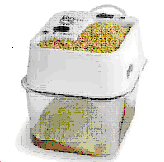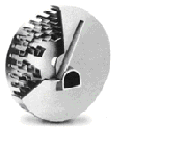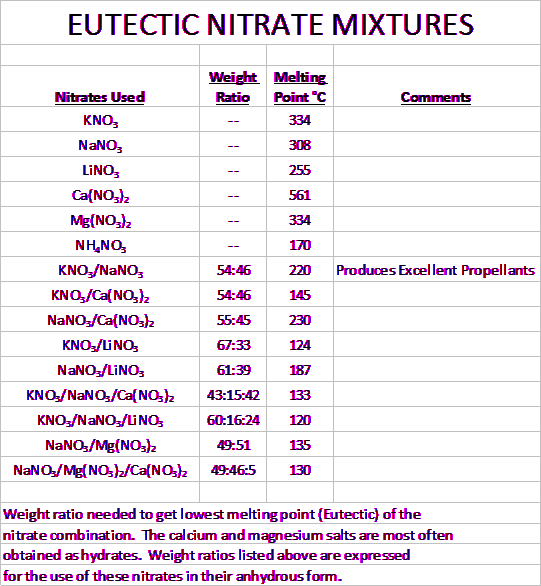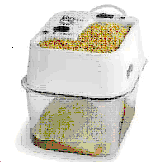Oxidizers
The oxidizer most often used in the preparation of sugar motors is potassium nitrate (KNO3). Other oxidizers can be used. Serge Pipko has documented on his web site some work using Sodium and Calcium Nitrates as well as mixtures of sodium and potassium nitrate. A section on such mixed oxidizers specifically devoted to low melting "eutectic" formulations can be reached at this link. Similar work that I have done is located at the Eutectic Oxidizer page of this site. Little, if any, work using ammonium nitrate/sugar mixtures has been reported by amateur propellant makers. This may be due to the fact that ammonium nitrate/sugar mixtures have been prepared industrially for use as blasting agents, similar to ammonium nitrate/fuel oil compositions. If high rates of detonation are associated with ammonium nitrate/sugar mixtures then they would not make safe propellants for amateur rocketry. Also, little, if any, documentation on the use of ammonium or potassium perchlorate with sugars has been placed on the web.
Potassium nitrate, the oxidizer of choice in most cases, can be obtained from a number of different sources. The least expensive source is to purchase it from a fertilizer supply outlet in 50 lb bags. A number of reputable sellers of KNO3 can be located on internet sites such as eBay. The price of such KNO3 is often 2 to 4 times more than the fertilizer route. Most expensive, but perhaps easiest to obtain, is to purchase KNO3 as “stump remover” (granular). Many stores such as Wal-mart and Lowe’s carry this material for $5-6 a pound.
For the average amateur sugar propellant maker there are two main issues that need to be addressed with respect to the oxidizer. The most important issue is the purity of the material. If a purchased material does not perform satisfactory it may be necessary to recrystillize the KNO3. The second important issue with respect to the oxidizer portion of a sugar propellant is its particle size. Most propellant makers like to grind their oxidizer to a small particle size (~100 mesh or smaller). Coffee grinders seem to be the method of choice for the average Joe. I grind my KNO3 using a K-Tec wheat grinder. It grinds via the process of micronization. Many small, stainless steel blades spin at high velocity. KNO3 grains are impacted by the spinning blades blasting them into smaller particles. The KNO3 powder obtained from this grinder is very fine. Over 50% of the powder is less than 300 mesh. I can grind a pound of KNO3 in less than a minute with the K-Tec. Such a grinder is expensive however (~$150 - $200). Grinding mixtures such as black powder would most likely not be safe with this method because of the high impact force of the blades.
Potassium nitrate, the oxidizer of choice in most cases, can be obtained from a number of different sources. The least expensive source is to purchase it from a fertilizer supply outlet in 50 lb bags. A number of reputable sellers of KNO3 can be located on internet sites such as eBay. The price of such KNO3 is often 2 to 4 times more than the fertilizer route. Most expensive, but perhaps easiest to obtain, is to purchase KNO3 as “stump remover” (granular). Many stores such as Wal-mart and Lowe’s carry this material for $5-6 a pound.
For the average amateur sugar propellant maker there are two main issues that need to be addressed with respect to the oxidizer. The most important issue is the purity of the material. If a purchased material does not perform satisfactory it may be necessary to recrystillize the KNO3. The second important issue with respect to the oxidizer portion of a sugar propellant is its particle size. Most propellant makers like to grind their oxidizer to a small particle size (~100 mesh or smaller). Coffee grinders seem to be the method of choice for the average Joe. I grind my KNO3 using a K-Tec wheat grinder. It grinds via the process of micronization. Many small, stainless steel blades spin at high velocity. KNO3 grains are impacted by the spinning blades blasting them into smaller particles. The KNO3 powder obtained from this grinder is very fine. Over 50% of the powder is less than 300 mesh. I can grind a pound of KNO3 in less than a minute with the K-Tec. Such a grinder is expensive however (~$150 - $200). Grinding mixtures such as black powder would most likely not be safe with this method because of the high impact force of the blades.

K-Tec Wheat Grinder

Micronizer blades









